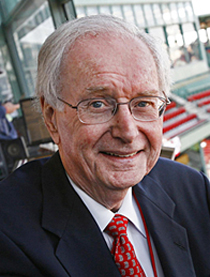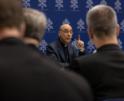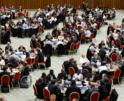
Culture
There is no denying that players are bigger, stronger, and more athletic than they were back in 1993, when the present standard between plate and mound was set.

Flavin
Several seasons ago, when Moses came down from Mount Sinai with the Ten Commandments, none of them said, "Thou shalt not change the distance between the pitcher's mound and home plate."
It was a bunch of guys who, after fiddling around with a variety of distances way back in the 19th century, decided the distance should be 60 feet, 6 inches; God had nothing to do with it. Therefore, we can safely conclude that, to consider changing the distance between the pitcher's rubber and the plate, does not constitute a transgression against divine law as some traditionalists would have us believe. So, baseball is considering it.
Beginning this Aug. 3 in the Atlantic League, an independent professional league, the distance from the rubber to the plate will be exactly one foot longer than is traditional, 61 feet, 6 inches. That doesn't sound like much, and maybe it isn't; but we're about to find out. Strikeouts at the major league level have increased slightly every year, and this year the rate is 9.4 per nine innings, as opposed to 1993, when it was only 5.4. That's way too many; it adds to the length of games, and it means too few balls are being put into play. It makes for dull baseball.
A 95 MPH fastball takes less than half a second from the time it leaves the pitcher's hand before reaching the plate. You wouldn't think that another 12 inches more or less would make much difference, but it could be crucial to a batter with blindingly quick reflexes and superior hand-eye coordination.
Of one thing we can be sure -- pitchers are not going to like the new distance. There'll be complaints about the greater risk of injury, which may or may not be the case. Certainly, it will create control issues; a curve ball that always broke over the outside corner for a strike might break 12 inches sooner and thus could end up several inches outside for a ball. Mariano Rivera, the Yankees' great closer who holds the all-time record for saves with 652, relied on a cut fastball that broke so late that hitters were unable to see it. He might have been less effective if the break came 12 inches earlier.
There is no denying that players are bigger, stronger, and more athletic than they were back in 1993, when the present standard between plate and mound was set. Pitchers throw harder, and relievers are trained to throw at maximum effort for just an inning or two. There is also the height factor; pitchers have become significantly taller on average than other players. The 2018 World Series winning Red Sox, for example, featured pitchers Chris Sale and Drew Pomeranz, both 6-6, David Price and Rick Porcello at 6-5, and the shrimp of the rotation, Eduardo Rodriguez, at only 6-2. That, compared to the outfield of Jackie Bradley, Jr., 5-10, and Mookie Betts and Andrew Benintendi, both 5-9. The greater height of the pitchers increases the length of their stride, thus giving them a release point far closer than the advertised 60 feet 6 inches.
Two questions remain: 1) What, if any, effect will the new distance have? And 2) what will the reaction of the Players Association be? Pitchers might hate it and batters might love it, creating an intra-family squabble, and they are often the most difficult to handle. Just ask Prince Harry.
In any case, the change of distance will not be as great as was originally intended. It was originally announced that it would be two feet longer, 62 feet, 6 inches, beginning in 2020. But the Atlantic League season was wiped out by COVID-19, which led to the new, modified change.
There is another change that takes effect in the Atlantic League (which consists of eight teams from the mid-Atlantic and southeastern states) this year. The strike zone is being modified. Balls and strikes are already being called automatically, which means that the MLB is probably not far behind, but this year in the Atlantic League the top of the zone is being shrunk and the home plate will be wider. Research shows that more contact is made on pitches on or slightly off the corners of the plate than on high hard ones. We'll see.
One other change is taking place in the MLB research laboratory, otherwise known as the Atlantic League. The designated-hitter rule is being modified. It will be in effect only for as long as the starting pitcher remains in the game. Once the starter is removed, pitchers must either bat for themselves or pinch hitters used. This is aimed at encouraging managers to go with starters longer and also to construct their rosters differently. It could also lead to the National League softening its long held opposition to the DH.
There is no guarantee that any of these experiments will ever be adopted by MLB, but they are at least being given a tryout. I know that if I were in the area and a game was scheduled between, say, the Long Island Ducks, the defending Atlantic League champs, and the Lancaster Barnstormers, I'd be likely to buy a ticket just to see how, and if, the changes work.
Getting MLB and the players association to agree on anything these days is almost impossible. Diplomatic relations between the two sides are at a low ebb. They are like Republicans and Democrats -- both sides know that their well-being depends on the strength of a common cause, but neither can bring themselves to trust the other. With the Basic Agreement between MLB and the union expiring after this season, there are dangerous storm clouds on the horizon.
Despite the huge contracts that a few players have landed since last season (Mookie Betts and Fernando Tatis, for example) pay days for most free agents are down considerably, and, with attendance still restricted by COVID-19, teams are in their second straight year of financial doldrums.
Baseball has real problems on a lot of levels. But at least it's recognizing them.
- Dick Flavin is a New York Times bestselling author; the Boston Red Sox "Poet Laureate" and The Pilot's recently minted Sports' columnist.
Recent articles in the Culture & Events section
-
'Dignitas' and the mediaRussell Shaw
-
Scripture Reflection for April 14, 2024, Third Sunday of EasterDeacon Greg Kandra
-
St. Helena's House is established in the South EndThomas Lester
-
Is this synodality?Russell Shaw
-
Poking the hornet's nest of IVFFather Tadeusz Pacholczyk


















